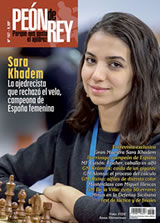111 Middlegame Crimes and Punishments
In this book, aimed at strong tournament players, he presents a broader approach to developing tactical and positional middlegame skills. Specifically, he presents 111 match positions from 2019 grandmasters, including super GMs like Magnus Carlsen, Fabiano Caruana or Ding Liren.
Most chess games end in the middle of the game. Therefore, to achieve good results, you must play well at this stage of the game. This half-game book by Grandmaster Alexander Galkin, who was named Children's Coach of the Year in 2016 by the Russian Chess Federation, and Female International Master Anastasia Travkina, provides a large volume of practical knowledge. The vast majority of half-game tactics and positional books contain a selection of positions and exercises in which the student is asked to find a tactic, carry out an attack against the enemy king, or choose the correct positional approach based on certain "rules". However, not much attention is paid to the mistake of one of the players that led to the critical position where the combination, decisive attack or positional improvement became possible.
In this book, aimed at players of strong tournaments (1900-2300 Elo or juniors who improve rapidly), the authors present a broader approach to developing the tactical and positional midfield skills needed by a formidable chess player. Specifically, they feature 111 grandmaster match positions played in 2019, including super-GMs such as Magnus Carlsen, Fabiano Caruana, Ding Liren, Anish Giri, Ian Nepomniachtchi, Daniil Dubov, Wesley So, Hikaru Nakamura, Levon Aronian and Wang Hao. , in which they first explain the mistake made by one of the players by underestimating their opponent's counterplay, then analyze how the game progressed where the mistake is punished. After that, they return to the starting position to demonstrate the correct or most promising continuation. Thus, the text is structured so that each challenge contains the initial diagram twice: before the moves in the actual game and then, on the back page, before the solution.
There are numerous elements that a chess player must take into account in the middlegame and the authors have designed this book to address thematic errors specific to the middlegame: wrong sacrifices, creation of imaginary threats, imaginary defense against threats, grabbing pawns, giving check or attack material, which is better? , incorrect assessment of changes in workforce structure, lack of vigilance in decision-making, substitution of tactics for strategy and incorrect positional decision-making.
Studying these key excerpts from grandmaster games will help the player develop his approach to middlegame. First, the student analyzes why a move or series of moves by one of the players was wrong. What counterplay did the player underestimate? Second, armed with this answer, the student can review the position to try to discover the best move. If the student is working with a coach, then the coach must first establish the position on the board, demonstrate the wrong move made and ask the student to find the refutation of that bad move. Once the student finds the refutation, the coach must once again establish the critical position and ask the student to find the strongest continuation for the starting player. It can be one or more movements, depending on the position. Naturally, in the case of self-study, the student can change their approach, either by trying to discover the refutation of the error by covering the next text, or simply by studying the moves in the game before trying to find the best continuation, which is detailed on the back along with the initial diagram.
Data sheet
- Product Type
- Paper
- Language
- English
- Theme
- Strategy
- Level
- Club
- Author
- Alexander Galkin, Anastasia Travkina
- No Pages
- 235
- Year published
- 2020
- Measurements
- 15.6 x 23.4cm
- ISBN
- 9785604177099





